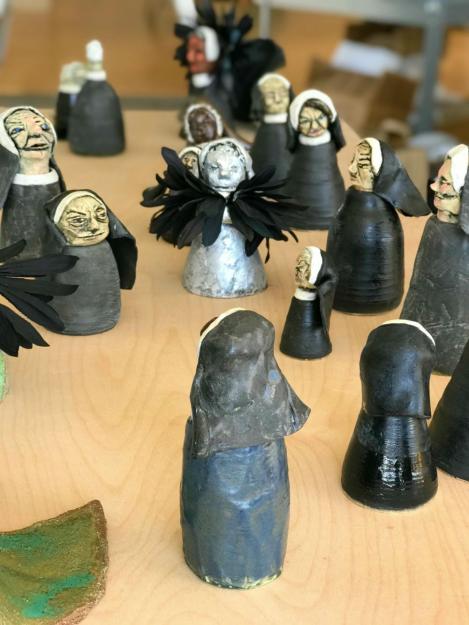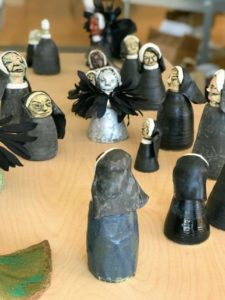Nuns and bishops

The New York Times last Sunday featured “The Sisters Project” about the “Nuns and Nones,” previously reported on by the NCR. , I mention the latter only to give us some insight into what is considered news by the broader journalistic community. This project is so hopeful: young, self-identified non-religious people live in convents where the sisters are mostly old; they explore together the meaning of life and other trivial topics and develop deep bonds. It’s such a far place from the sex abuse scandal and church politics. And it’s mainly, but not exclusively, women. The photos are great, especially the two on the front page of the Style section: a young woman in focus in one and a nun in the other.

On a different scale are the ceramic images created by Lexa Walsh for her show, “Oh, Sister.” This “collection of sculptural vessel-portraits (statues that are also functional jars) of the sisters she remembers, who she says both ‘taught and tormented’ her” is not likely to get noticed by the NYT, but maybe by a paper in California or anyone interested in the plastic arts. This young woman experienced nuns in much the same way I did, including the fair and calm Sister Regina (!) and the grammar enforcer Sister Patricia, The interview brought to mind Greta Gerwig’s Lady Bird, also set in a California Catholic school.
Now to the Bishops, who are meeting next week for their annual spring conference. This has a more public agenda than the California event where we witnessed in 2016; this year they need to discuss implementing the Pope’s sex abuse directives. Michael Sean Winters summarizes this and several other issues, including a caution about a lay oversight body.
Perhaps because of this meeting, Heidi Schlumpf also writes about the U.S. Conference of Catholic Bishops (USCCB). In the first of two articles, she covers “the basics,” which is more than the headline suggests. Would you believe that the Philadelphia (22) and Chicago (11) Provinces “have produced the most bishops”? I’d like to look at the consequences of that, as well where the bishops say they get their news:
Almost half of U.S. bishops who responded to the survey said they watch news on the FOX channel; only 4% watch MSNBC. The most popular daily source of secular printed news is a local daily newspaper (88%), with The New York Times the most frequently mentioned national newspaper (38%).
The National Catholic Register (owned by EWTN) is the most frequently read religious periodical, with self-identified traditionalist or even moderate bishops more likely than progressives ones to read it (Still, 40% of progressive bishops did). The opposite was true with America magazine, which came in second with 60% of bishops reading, but more progressive bishops more likely to read it than traditionalists. Only 33% of bishops read the National Catholic Reporter.
We know even bishops are not well educated in contemporary theology; now, in my opinion, they are not likely to be well informed about contemporary events, either. (I did hear a report on NPR that they had issued a statement on gun control after the Virginia Beach atrocity. Lots of statements come out with little effect, but I was glad to see them get this one heard, at least by me.)
Schlumpf ‘s second article analyzes the complex politics of the bishops, where no one is an “ideological liberal.” Rather, there are progressives, moderate conservatives, plus, of course, “ideological conservatives,” according to longtime columnist Tom Reese. Not surprising if you consider where they get their news.
Schlumpf reports that only 20% of the bishops have been appointed by Francis, and their votes don’t show a clear voting block. She quotes Cathleen Kaveny, a law and theology professor at Boston College, as saying they “tend not to be locked into the old culture-war model” which Kaveny believes “doesn’t work post-sex-abuse.”
These “culture of encounter” bishops have adopted Francis’ image of the church as “field hospital,” where there is “more room for grappling with the messy and complicated details of people’s lives,” she said.
But rather than engage in “fruitless fights,” this smaller group of bishops — which can include both conservatives and liberals — are instead “changing the topic” and trying to model the “culture of encounter in their own dioceses,” Kaveny said. …
This attitude may come from pastoral experience, as fewer of Francis’ appointments come straight from high-powered positions in chanceries. …
91% of Francis’ appointees have served as pastors, compared to 62% under John Paul II.
Of course, “simply being a pastor does not necessarily mean you’re pastoral,” said Reese.
I’d like to assume that bishops have access to the study this article is based on, though if they also get NCR they might know outsiders’ views of what they probably observe as they interact.
And we have to hope that there are strong decisions made at this meeting that are as well reported as the various lapses of bishops and cardinals, the latest being USCCB head DiNardo.
Schlumpf concludes her second article by with a consideration of lay boards of review – remember that from Winters, above? It’s not as simple as it seems. Both these NCR authors and others have covered the expanding influence of wealthy and conservative Catholics as the hierarchy seems to be at a loss. You’ll have to find those articles yourself. Maybe if those laypeople were nuns I’d be more reassured.

4 Responses
The fact that so many use FOX news as their source is deeply troubling and in contrast to truth.Jesu let us know the truth will set us free.Scary to me asan informed Catholic!
Re. https://www.americamagazine.org/sites/default/files/attachments/Vatican_Gender_Male_and_Female_He_created_them.pdf
The best way to foster doctrinal development pursuant to the ordination of women is to keep exposing patriarchal gender ideology as an obsolete, artificial, and unnatural GENDER THEORY.
I am trying to decide whether to write on the Vatican pronouncement Luis links to — or two new documents about deacons. Any preferences among you readers?
Sorry that the service had a glitch last week. I like coming out on Saturday mornings.
Hard to decide which topic to choose – I guess we could steel ourselves to hear about the “unnatural gender theory” especially with your analysis and commentary. but it’s always good to look forward and so I guess I would vote for the deacons.